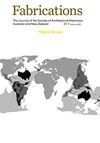Navigating Encounters and Exchanges: Intercolonial Trade, Industry and Labour Mobility in Asia Pacific, 1800s – 1950s, Fifth Annual International Symposium of Australian Centre for Architectural History, Urban and Cultural Heritage, University of Melbourne
IF 0.3
0 ARCHITECTURE
Fabrications-The Journal of the Society of Architectural Historians Australia and New Zealand
Pub Date : 2022-01-02
DOI:10.1080/10331867.2022.2047455
引用次数: 0
Abstract
The fifth annual International Symposium of the Australian Centre for Architectural History, Urban and Cultural Heritage at the University of Melbourne, Navigating Encounters and Exchanges: Intercolonial Trade, Industry and Labour Mobility in Asia Pacific, 1800s – 1950s , was held online from 24 to 26 November 2021. The symposium highlighted industrial heritage in the Asia-Pacific region and its global connections. With a focus on buildings for industry, agriculture, and trade, it explored themes of encounter, exchange, and influence, through flows of commodities, craft, labour and expertise across sites and communities between the 1800s and the 1950s. The symposium was convened by Amanda Achmadi, Hannah Lewi, Soon-Tzu Speechley and Paul Walker, with presentations by local and international academics and heritage practitioners. Due to the COVID pandemic, digital pre-recorded presentations were available prior to syn-chronous keynotes and panels attended by guests and speakers across the globe. The first keynote, presented by Julia Martínez (University of Wollongong) and Adrian Vickers (University of Sydney), examined the relationship between the prolific use of corrugated iron and seasonal multi-ethnic workforces in pearling, mining and plantation industries across Asia-Pacific in the early- to mid-20 th century. Cheap, portable, and easily assembled, corrugated iron was imported from Australia by Australian enterprises to construct racially segregated work, living and entertainment spaces for labourers. The keynote traced how different building typologies emerged based on racial and class divides, despite global pressure to improve living conditions.航行相遇与交流:19世纪至50年代亚太地区的殖民地间贸易、工业和劳动力流动,第五届澳大利亚建筑历史、城市和文化遗产中心国际研讨会,墨尔本大学
墨尔本大学澳大利亚建筑历史、城市和文化遗产中心第五届年度国际研讨会于2021年11月24日至26日在线举行,主题为“相遇与交流:19世纪至50年代亚太地区的跨殖民贸易、工业和劳动力流动”。研讨会强调了亚太地区的工业遗产及其全球联系。它以工业、农业和贸易建筑为重点,探讨了19世纪至50年代期间,通过商品、工艺、劳动力和专业知识在各个地点和社区的流动,相遇、交流和影响的主题。研讨会由Amanda Achmadi、Hannah Lewi、Soon Zi Speechley和Paul Walker召集,当地和国际学者以及遗产从业者进行了演讲。由于新冠肺炎疫情,在全球嘉宾和演讲者参加同步主题演讲和小组讨论之前,可以使用数字预录演示。第一次主题演讲由Julia Martínez(卧龙岗大学)和Adrian Vickers(悉尼大学)提出,研究了20世纪初至中期亚太地区珍珠、采矿和种植业中波纹铁的大量使用与季节性多民族劳动力之间的关系。廉价、便携、易于组装的波纹铁是澳大利亚企业从澳大利亚进口的,用于为劳动者建造种族隔离的工作、生活和娱乐空间。主题演讲追溯了在全球面临改善生活条件的压力的情况下,基于种族和阶级划分的不同建筑类型是如何出现的。
本文章由计算机程序翻译,如有差异,请以英文原文为准。
求助全文
约1分钟内获得全文
求助全文
来源期刊

CiteScore
0.50
自引率
25.00%
发文量
26
 求助内容:
求助内容: 应助结果提醒方式:
应助结果提醒方式:


